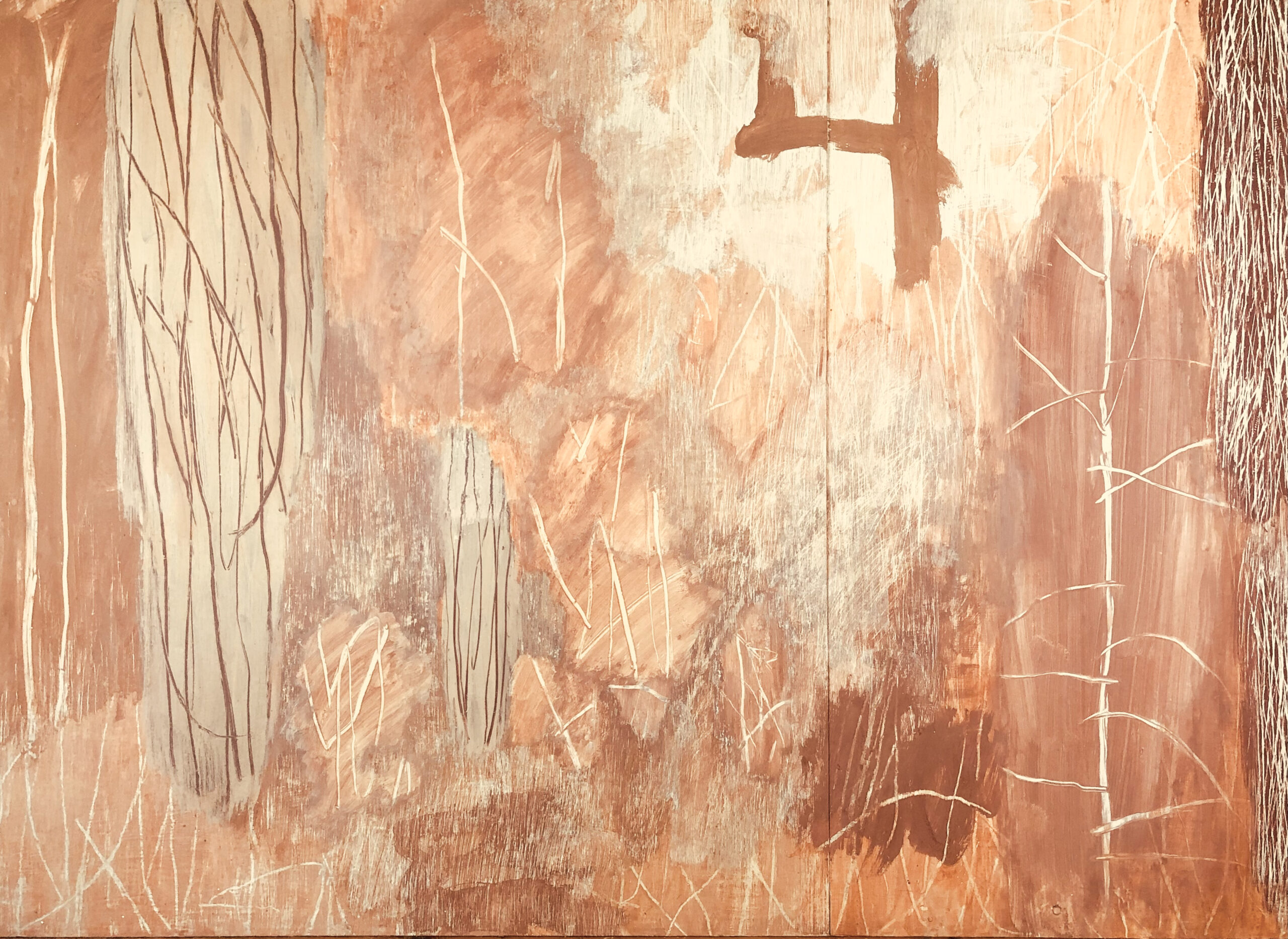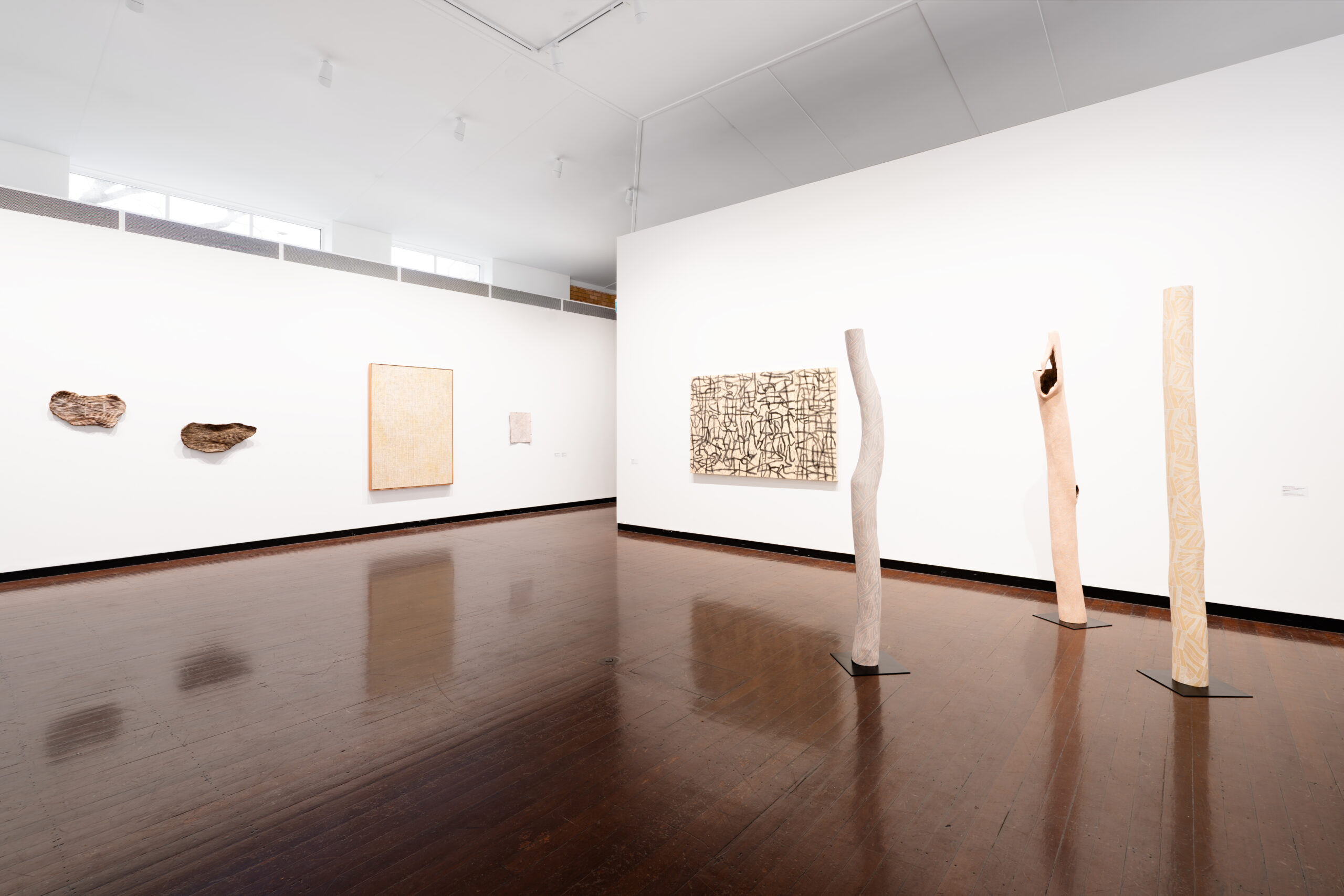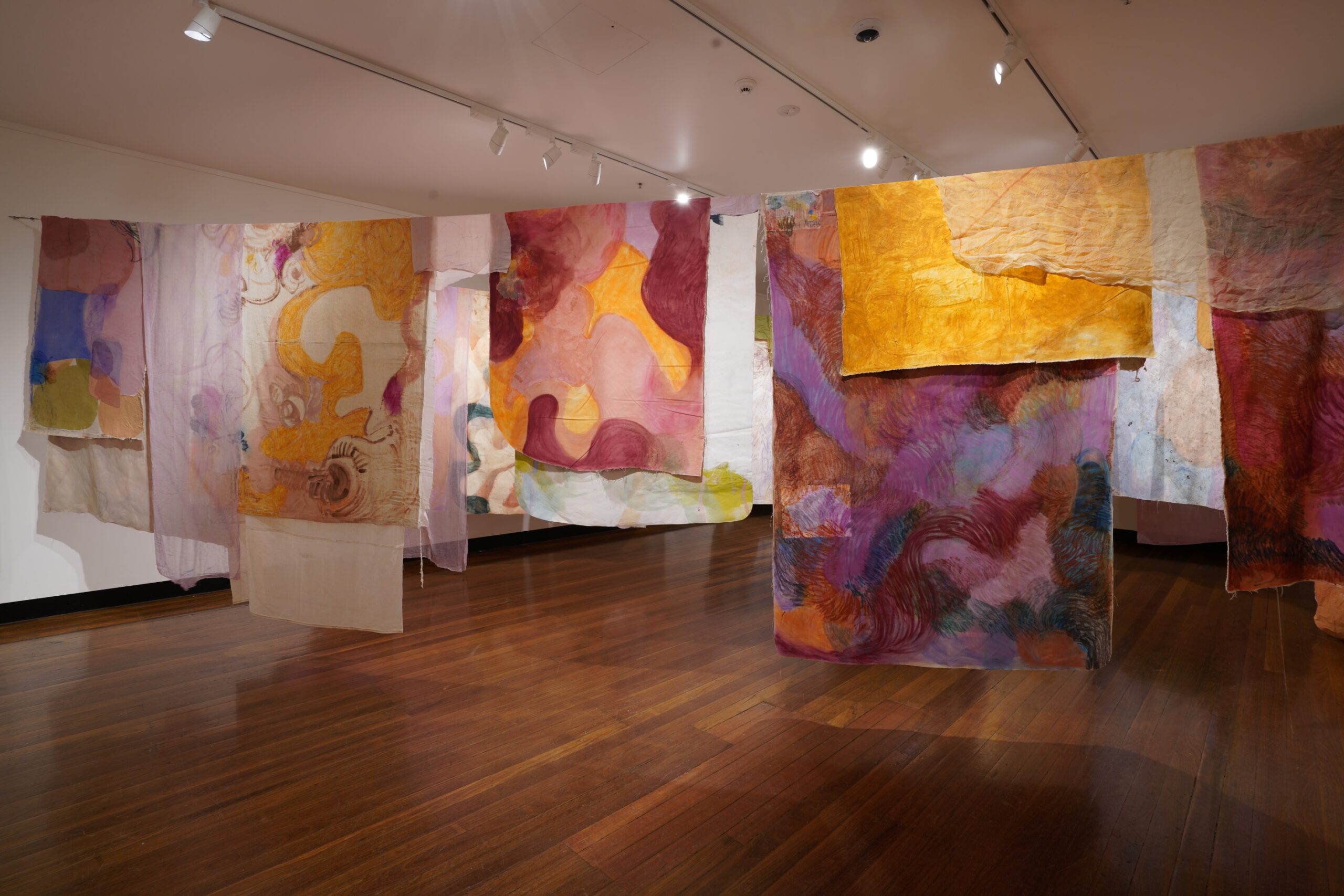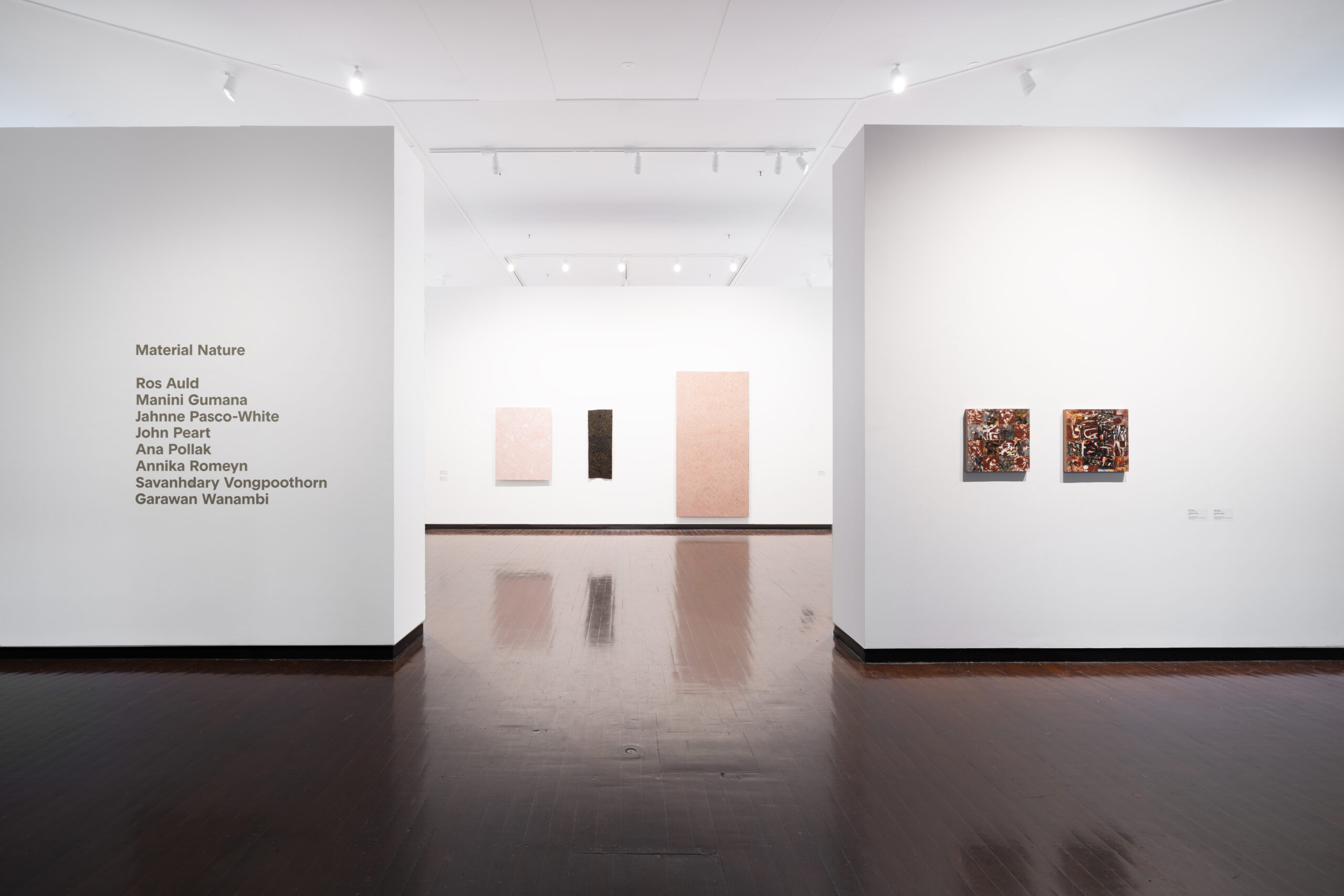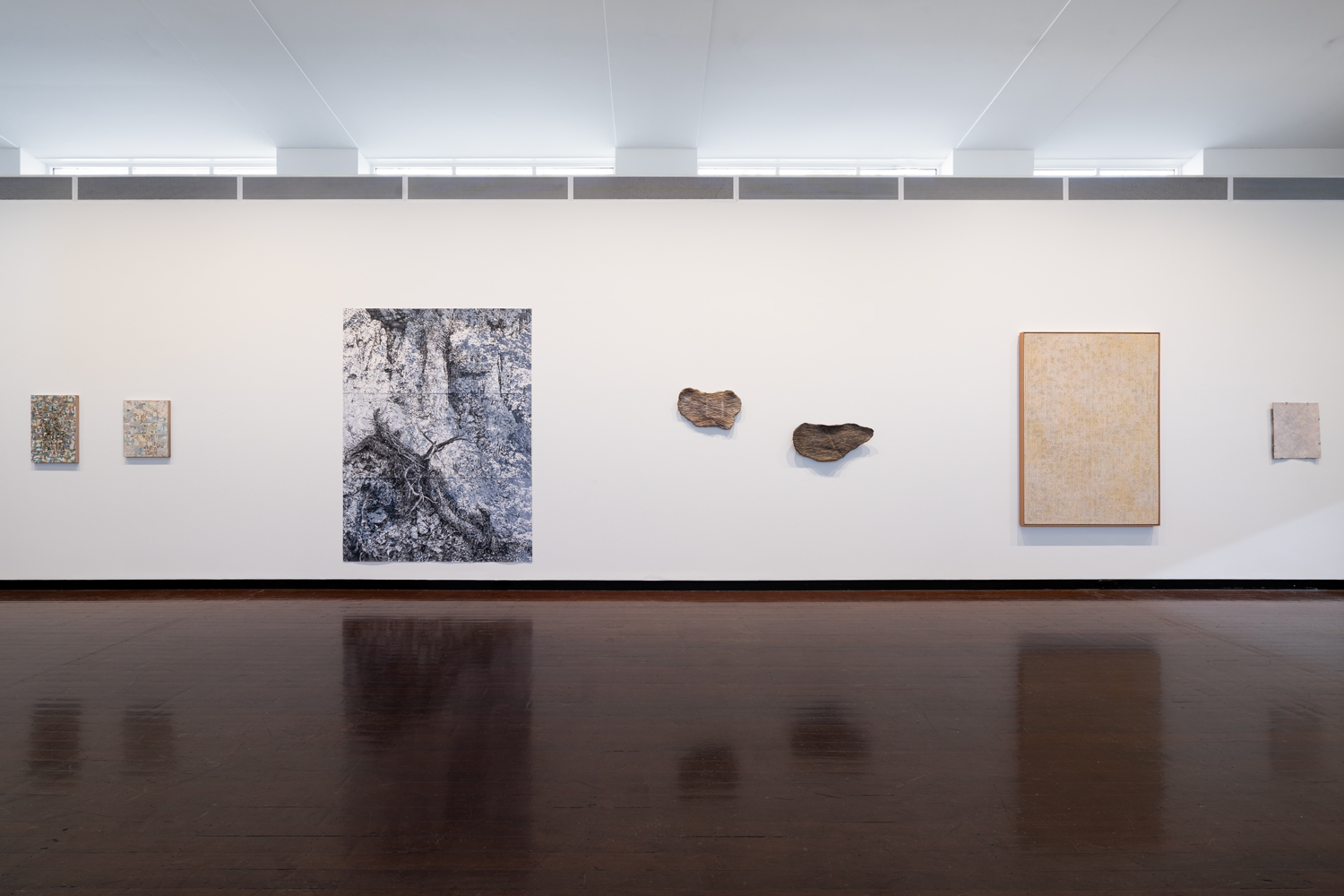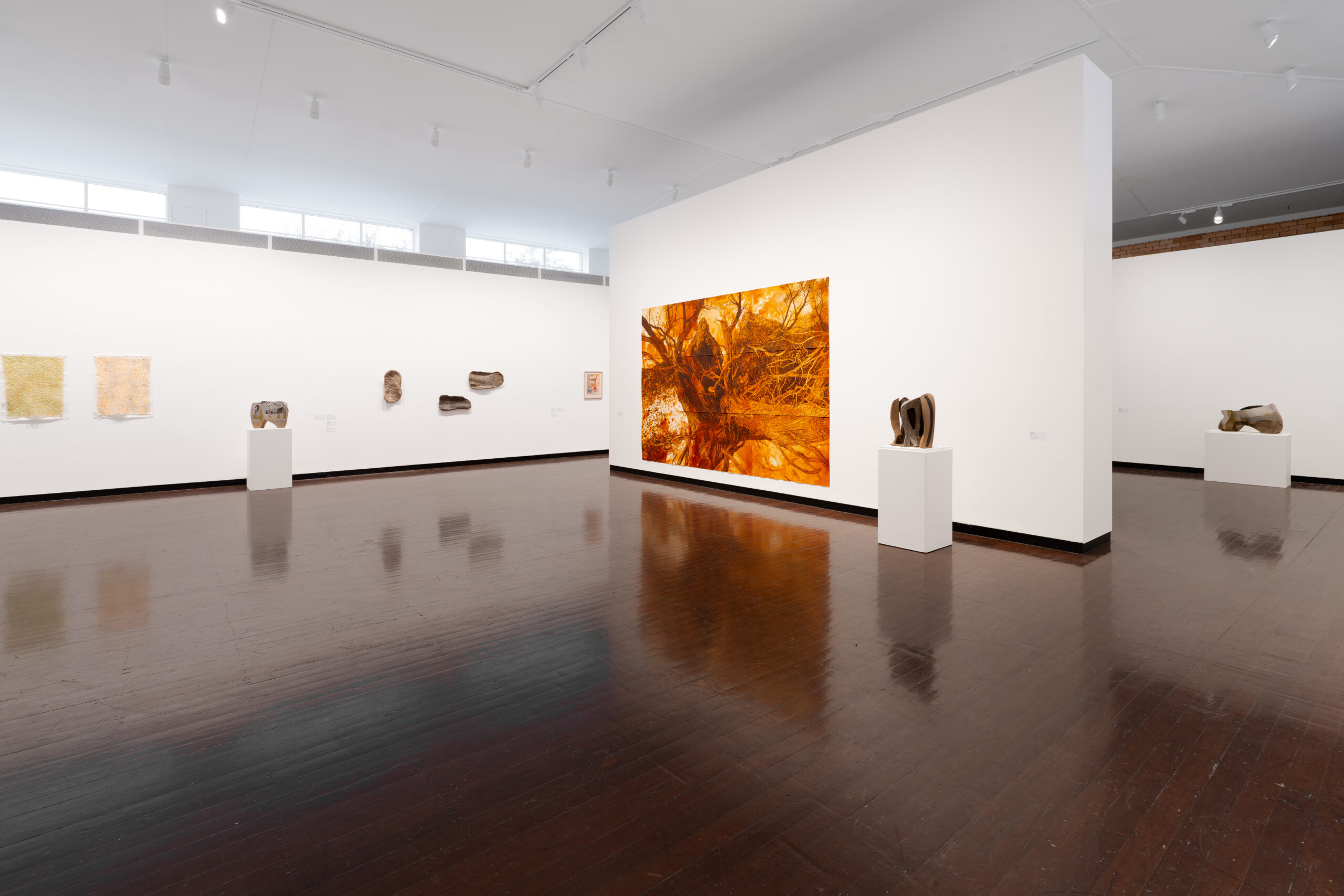- Date20 June – 10 August, 2025
- Opening19 June, 6pm
- CuratorDr Anne-Marie Jean
Material Nature looks to the power of materials to engage our multi-sensory experience of the natural world. With a focus on embodied awareness, the conventional idiom of landscape painting is collapsed, the viewer no longer positioned outside nature, but within. Works by artists Ros Auld, Manini Gumana, Jahnne Pasco-White, John Peart, Ana Pollak, Annika Romeyn, Savanhdary Vongpoothorn and Garawan Wanambi invite contemplation of our inter-relations with ecologies.
Join us for the opening of Material Nature on Thursday 19 June, 6pm. Officially launched by Dr Rebecca Mayo, Senior Lecturer, ANU School of Art & Design and Welcome to Country by Paul Girrawah House, senior Ngambri-Ngunnawal custodian of the Canberra region.
Install Images
Ros Auld
Ros Auld is an Australian artist who works principally in sculptural ceramics. She studied painting and ceramics at the National Art Schools in Newcastle and Sydney, and in 1975 worked in the ceramic studio of the painter John Piper, in England. On returning to Australia, she taught visual arts and ceramics at tertiary level for a number of years before concentrating on her own work at her studio near Orange.
Landscape is a continuing source of inspiration and theme through Auld’s work. She speaks of her reflections of landscape more as “the accumulation of recollected impressions than particular sites… the weathered surfaces, textures and subtle colours of the Australian bush; the patterns in the cultivated landscape.” The contrasting strengths and fragilities of nature are felt in the bold forms with complex surface textures and glazes of her large hand-built vessels, and steel and ceramic sculptures.
Auld has enjoyed collaborations with other artists, most notably Euan Macleod, John Olsen and Tim Winters. She has exhibited widely, and her work is held in many galleries and private collections in Australia and overseas. Auld is represented by Art Atrium in Sydney and Messums in the United Kingdom. https://www.rosauld.com.au/
Manini Gumana
The fertile soils of Gängan in East Arnhem Land are home to a tangle of sprawling Stringybark Forest, a feast of freshwater marine life, and a concentrated enclave of some of Australia’s most globally celebrated artists. Manini Gumana is a product of this land. The daughter of Dhaḻwaŋu clan leader Dhakawa Gumana, trained by her uncle the famous artist Gawirrin Gumana AO, married to celebrated Marrakulu painter Garawan Wanambi, Gumana’s connections are strong.
As one of the younger generations of Yolŋu artists living in Gängan, Gumana is known for her innovative approach. She was the first Yirrkala artist to paint her design directly onto naked bark, resulting in an undeviated corelation between materials and subject matter that aligns with the Yolŋu Gurrutu system. From 2012, she has become the first artist to apply the template or skeleton of the composition using just a marwat (a brush made from human hair attached to a short twig). Previously this was done with a machine-made brush, before the marwat was used to fill in the rarrk (cross-hatching).
Gumana is the only artist in Gängan to paint the Mungurru (the deep ocean off the coast of Blue Mud Bay). In her work the relentless energy that animates the Mungurru is echoed in the natural ripple of the Stringybark and enhanced by Gumana’s morphing patterning and the optical play of bold forms rendered through the cumulation of a myriad of delicate rarrk.
In recent work Gumana has begun mixing earth pigments with gapan or white clay to create bright pastel natural colour ranges. In 2019 Gumana’s innovative pastel coloured ḻarrakitj (Stringybark poles) were included in the groundbreaking exhibition Gurrutu for Tarnanthi Festival at the Art Gallery of South Australia. Her works are held in major institutional and private collections. Manini Gumana is a member of the Buku-Larrngay Mulka Art Centre at Yirrkala, Arnhem Land.
Jahnne Pasco-White
Jahnne Pasco-White lives and works in Gadigal/Sydney. Her expanded painting practice explores the interconnectedness between humans and our environment. Her intuitive, generous style of abstraction articulates itself in raw, gestural paintings on fabric and canvas. Hand dyed fabrics pigmented with organic materials gathered from her surroundings – including domestic debris and matter collected from the natural environment – are complemented by acrylic paint, oil stick, pastel and crayon. Into these surfaces, she introduces segments of old paintings, cut up and reworked in an ongoing cycle of decay and renewal. Pasco-White is interested in the generative process of creating, and the layers of authorship that are variously revealed and concealed by mark-making and her continuous process of addition, subtraction and reworking.
Pasco-White was the winner of the prestigious Arthur Guy Memorial Painting Prize in 2019, and a finalist in the 2019 Ramsay Art Prize, Australia’s premier prize for emerging artists. She was the recipient of a 2018 Art Gallery of New South Wales’ Moya Dyring Memorial Studio scholarship at the Cité Internationale des Arts in Paris, and was awarded a Martin Bequest Travelling Scholarship for Painting 2018-20 from the Australian Council for the Arts. Pasco-White has completed residencies in Germany, Italy, Iceland, New Zealand, and Australia, including at LIA in Leipzig, the Rome Art Program, the Icelandic Nes Artist Residency, and Gertrude Contemporary. Pasco-White recently completed a Masters of Fine Art at Monash University, where she was a student representative on the Climate Task Force. Pasco-White is represented by Station Gallery, Melbourne and Sydney. https://jahnnepascowhite.com/
John Peart
John Peart is recognised as a significant Australian abstract artist whose diverse and prolific artistic career spanned nearly 50 years. He was born in 1945 in Brisbane and died at Wedderburn, NSW in 2013.
In 1962 at the age of 16, Peart left his hometown of Brisbane and moved to Sydney to pursue his career as a painter. He soon befriended gallery director Frank Watters and it was the beginning of a long artist/gallery relationship. Watters Gallery represented Peart’s work from 1965 until the gallery closed in 2018.
Throughout the late 1960’s and 1970’s Peart lived and worked in the US, Europe, UK and India. In 1975 he returned to Sydney where he continued to paint and began teaching at the National Art School. In the early 80’s he was invited by fellow artist Roy Jackson to join the Wedderburn community of artists in NSW where he lived and worked for the rest of his life.
Peart’s oeuvre varies across the decades demonstrating an exuberant drive for experimentation and a lifelong curiosity that informs his work.
Over the course of his career, Peart held over 35 solo exhibitions and was involved in a significant number of group exhibitions. His paintings featured in major curatorial exhibitions including the 1968 exhibition ‘The Field’ at National Gallery of Victoria; ‘Recent Australian Art’ at the Art Gallery of New South Wales (1973); and ‘Field to Figuration’ at the National Gallery of Victoria (1986). He was the recipient of a number of major art prizes, having won the Wynne Prize at the Art Gallery of NSW in 1997 with his work ‘Nandi Moon’, the Sulman Prize in 2000, and was a finalist in the Archibald Prize in 1998. In 2004, the Campbelltown Arts Centre organised a retrospective exhibition ‘John Peart – Paintings 1964-2004′ which toured galleries throughout Australia, including the Drill Hall Gallery in Canberra. John Peart’s works are held in the National Gallery of Australia as well as all State Galleries and many private and corporate collections throughout Australia.
From The Estate of the late John Peart
King Street Gallery on William, Sydney and Charles Nodrum Gallery, Melbourne represent the John Peart Estate.
Ana Pollak
Ana Pollak lives and works on Dangar Island on the Hawkesbury River. Her work includes painting, drawing, sculpture and animated film.
Pollak studied at the Byam Shaw School of Painting and Drawing in London in 1976 and then the Alexander Mackie School of Art in Sydney until 1980. While studying in Sydney Pollak created a sculpture program with the North Rocks School for Blind Children. Since 1988 she has set her focus on caring for and protecting the living environment through her active involvement in community groups and has coordinated several community art projects.
Being immersed in nature is a key part of Pollak’s artistic practice. She has travelled extensively on drawing and painting trips across Australia and participated in artist residencies in Australia and Hong Kong. In 2007 she was awarded the Dobell Prize for Drawing. Pollack has produced three significant animated films, including Flux, an edition of which she has generously donated to ANU Art Collection. Her current practice spans painting with clay slips and oxides on plywood and carving. Ana Pollak is represented by Defiance Gallery, Sydney. http://www.anapollak.com.au
Annika Romeyn
Annika Romeyn lives and works on Ngunnawal, Ngunawal and Ngambri Country in Kamberri/Canberra. She combines drawing, printmaking and painting to create intricate and immersive works on paper.
Romeyn is drawn particularly to the threshold of rock and water. She revisits sites in nature over days or years, circling back to place in a walking practice that creates multiple perspectives. Processes of seriality and layering in her work suggest this accumulation of experience, memory, perception and personal significance. Romeyn’s embodied experiences of nature extend to her making processes. She often scales her work in relation to her outstretched body and uses her fingertip as a mark-making tool, embedding a sense of care and value in the environments she depicts.
Romeyn graduated from the ANU School of Art and Design (Printmedia and Drawing) in 2010 after undertaking a liberal arts education on scholarship at Morgan State University, Baltimore, USA (2005 – 2009). Field-based residencies and cultural exchanges have been significant to Romeyn’s practice – these include the Embassy of Spain’s Torres Travelling Scholarship (2011); Bathurst Regional Gallery’s Hill End Residency (2015); Bundian Way Arts Exchange on Yuin Country (2019); and Broken Hill City Art Gallery’s Open Cut Commission (2022). She has been awarded the River of Art Prize (2024); the Canberra Arts Patrons Organisation’s Mandy Martin Art and Environment Award (2023); the Burnie Print Prize (2021); the Fisher’s Ghost Art Award (2020); and the National Works on Paper prize (2020). Annika Romeyn is represented by Flinders Lane Gallery, Melbourne. http://www.annika-romeyn.com
Savanhdary Vongpoothorn
Savanhdary Vongpoothorn is a painter, sculptor and installation artist known for her perforated canvases and intimate works on paper. She studied visual art at Western Sydney University and completed a Master of Fine Art at the University of New South Wales (CoFA).
Recognised as one of Australia’s leading artists from the South-East Asian region, Vongpoothorn arrived in Australia with her family when the artist was eight years old, having fled Laos in 1979. Her deeply contemplative work is remarkable in sustaining creative and critical relationships with multiple influences. Marked by an enduring interest in her South-East Asian origins and their relationship to contemporary Australia, her work bridges contemporary realities with historical reference, advancing a practice that is inherently hybrid and polyvalent.
Vongpoothorn is included in most national public and numerous private collections. Her work has received international recognition and in 2019 she was the subject of the important survey exhibition All that arises at Drill Hall Gallery. Savanhdary Vongpoothorn lives and works in Canberra. She is represented by Niagara Galleries in Melbourne and Liverpool Street Gallery in Sydney.
Garawan Wanambi
Garawan Wanambi is a Marrakulu clansman and artist who works out of the Buku-Larrnggay Mulka Centre in Northern Arnhem Land. After his father’s death in 1973, Wanambi was brought up by Wayuŋga Wanambi of the Marraŋu clan. Through this connection, Garawan paints Marraŋu designs. He now lives, with his wife, artist Manini Gumana, in her homelands at Gängan in East Arnhem Land.
Wanambi is recognised as one of the most gifted of the new generation of artists based at Gängan. His work extends the history and practice of Yolŋu painting. Whilst continuing to use natural pigments and miny’tji (sacred clan designs), he draws out the possibilities of these methods through his mixing of gapan (white clay) to form unique pastel colours creating deliberate tonal variations. His precise geometry and complex layering of designs create a depth of field on an otherwise flattened surface and a mesmerising optical effect. In doing this, Wanambi explores the Yolŋu concept of Buwayak ‒ simultaneously making elements both visible and invisible.
Wanambi’s works are in significant public collections, and in private collections both nationally and internationally. He was a finalist in the Telstra Art Prize in 2009, 2014, 2020, and a finalist in the Kate Challis RAKA Award in 2013. In 2014 he was awarded the National Aboriginal and Torres Strait Islander Art Award Best Bark painting prize. Wanambi is represented by Hugo Michell Gallery in Adelaide and Short Street Gallery in Broom.
Installation view of Material Nature, Drill Hall Gallery
The Drill Hall Gallery acknowledges the Ngunnawal and Ngambri peoples, the traditional custodians of the Canberra region, and recognises their continuous connection to culture, community and Country.
Contact
Close
Subscribe
Close
Close
